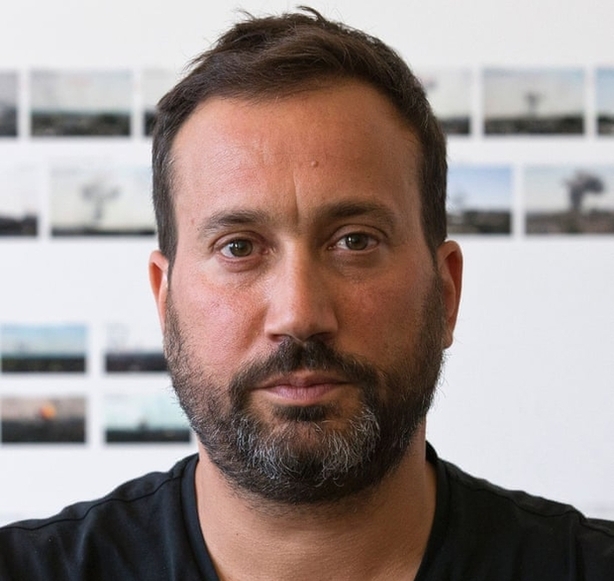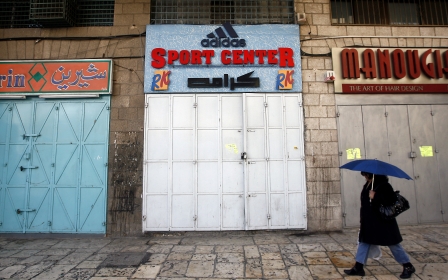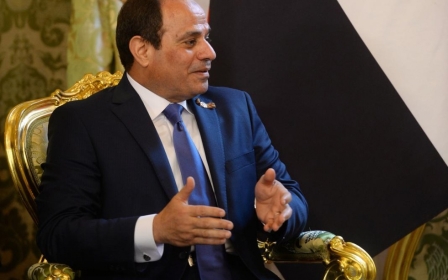'A gunshot, a speech, a whisper': The art detectives exposing Middle East crimes

Some eyebrows were raised with the announcement of the Turner Prize shortlist earlier this year. Known for showcasing the most cutting edge of British visual art, the awards committee made a daring move by nominating a piece by the collective Forensic Architecture.
Equally admired by art curators and human rights organisations and reviled by oppressive regimes, the work of the Goldsmiths, University of London-based group is revolutionary, utilising a multitude of tools from different disciplines – architecture, art, film, surveillance technology – to examine crimes overlooked by mainstream media or deliberately dismissed and distorted by the perpetrating governments. Its work has been prominently displayed in art galleries as well as in international criminal courts.
The Long Duration of a Split Second, the piece up for the prize, is a phenomenological work that leans more towards investigative journalism than art, or at least the commonly held notion of it.
The report tracks down the killing of a Bedouin villager and an Israeli police officer during an Israeli raid on Umm al-Hiran village, in the Southern Negev region in January 2017. The Israeli government claimed that the episode was a terror attack carried out by the Bedouin villager.
Using eyewitness accounts, video footage of the event shot in real time on cell phone, autopsy reports, new reports from Al Jazeera, and analysis of sound and wind direction to reenact the incident, Forensic Architecture proved that the Bedouin villager, who was driving, was, in fact, shot first by an Israeli policeman, causing him to lose control of his vehicle and run over the other policeman.
Although Forensic Architecture didn't go home with the Turner Prize, which went instead to Scottish artist Charlotte Prodger's deeply personal memoir of her coming out as gay in rural Scotland, the collective's work was the most envelope-pushing of all the shortlisted Turner nominees. It is an art whose raison d'être is founded on one key functionality: the unveiling of truth, or rather the questioning of an accepted truth.
Sometimes art is not taken seriously, taken as a form of pastime leisure ... We need to make sure it doesn't become as such
- Eyal Weizman
During an interview with Middle East Eye, founder and director of Forensic Architecture, Eyal Weizman, underplayed the Turner nomination. "We certainly welcome the attention brought about by the Turner nomination. However, it's a careful and ambiguous kind of embrace. Sometimes art is not taken seriously, taken as a form of pastime leisure," he said. "We need to make sure it doesn't become as such. We need to make sure that our presence in the art world contributes to it."
For Weizman, the showcase in art spaces does not fundamentally change the nature of his work; for him, galleries function as democratic means of arbitration.
"We do not always trust the court when it comes to issues of not only accountability in Palestine but in other places in general. We find that courts could themselves be instruments of dominations; the law could be geared against the weak instead of helping the weak. For us, what's important for our work is to make it public; to make evidence political; to make evidence part of the struggle, or part of resistance," Weizman said.
"In that sense, it is very important to place this evidence in different forums that are accessible to the wider public, whether they are the media, universities, truth commissions, human rights reports, people's tribunes, or indeed, galleries."
A debt to Palestine
Founded in 2011, Forensic Architecture is the brainchild of the Haifa-born Weizman, the celebrated Israeli-British architect who courted controversy at the beginning of his career when he presented an exhibition in 2002, which examined the Israeli settlements built on the occupied Palestinian territories as part of an international conference for young Israeli architects in Berlin.
Subsequently, the Israel Association of United Architects scrapped the show after it became clear that it criticised illegal Israeli settlements in the West Bank and wiped it off its catalogues.
Weizman became an instant cause celebre, bringing him instant notoriety before he got selected for the Venice architecture biennale the same year.
For Weizman, his practice owes a debt to Palestine; a place he describes as a "laboratory for examining new techniques of domination".
"Resistance to the Israeli domination has been a laboratory itself. The actions of various organisations of resistance have inspired different movements worldwide. The very idea of intifada has migrated to describe other forms of resistance leaderships," Weizman told MEE.
"These peaceful, non-violent techniques of resistance employed by civil society have stemmed out of Palestine to the rest of the world. It's in Palestine where user-generated videos showing different violations became a powerful tool; a tool for civil resistance. Cartography, or the counter-cartography of the occupation – a Palestine-originated notion that was called for by Edward Said – has also become a form resistance."
A good example according to Weizman is Mexico. Among the well-known cases Forensic Architecture has taken on was the 2014 mass disappearance of 43 students in the southern city of Iguala after being attacked by police forces.
You had a situation where the techniques and technologies developed against Palestine are now played out in Syrian and Russian bombings; in Ukraine; in many places
- Eyal Weizman
The group used plenty of techniques developed in Palestine to uncover this mystery, including civil society investigations to counter forensics. An ironic twist occurred when the group found out that the mobile phones and personal computers of their Mexican colleagues were bugged with Israeli spyware.
"You had a situation where the techniques and technologies developed against Palestine are now played out in Syrian and Russian bombings, in Ukraine; in many places. We don't see a globalisation of Israeli-Palestinian conflict, but we see it operating as a laboratory producing the means and sensibilities for suppressing other people," Weizman said.
"We see it in the building of walls, in separating people, in holding out refugees, in the use of different surveillance technologies. We see it in how the rising popular right across the world are looking up to Israel."
Diverse cases
Over the years, Forensic Architecture has taken on a number of cases in some of the thorniest places on the planet: the torture and killings in Syria's Sednaya Prison; the murder of a 21-year-old Turkish-German man by a neo-Nazi in Kassel, Germany; the execution of women and men accused of supporting Boko Haram in Cameroon's secret chambers, among others.
This year's The Long Duration of a Split Second, which has been displayed at the Tate and the Institute of Contemporary Arts (ICA) in London, illustrates the prowess of the assembly.
The multiple screens resemble fragments of an abstruse story; a thorough deconstruction of allegedly visual facts that demonstrate the slippery nature of the image.
The new-found attention to the case was also a means for the collective to acquire a prominent slot at the Tate – a space that "sometimes doesn't easily show work on Palestine" as Weizman puts it – after it was "almost marginalised at the ICA," and to reopen the case after it had gone cold.
Challenging the establishment
Art and architecture remain fundamental components of Weizman's work, not only in the tools used in the investigative process but in the basic construction and composition of the work as a whole.
"A lot of the evidence exists in activist video form, and that's why we need people, image practitioners to be exact, who know how to edit and combine this evidence. Sometimes we need to build very precise architectural models to help people recall events that are too traumatised to recall. Sometimes we need psychologists," Weizman said.
"Sometimes the process is centred on listening, to a gunshot, or a speech, or a whisper, which require the expertise of audio artists such as [award-winning Jordanian artist] Lawrence Abu Hamdan."
We'd never cut a video that is evidence; we put all videos in their original length. After all, who are we cut to evidence? Who are we to decide what you see and what you don't?"
- Eyal Weizman
Partnering with various human rights organisations such as Amnesty International, the European Centre for Constitutional and Human Rights (ECCHR), and Human Rights Watch, the group has repeatedly refused to collaborate with governments. It asserts that these governments have enough means to carry out their own investigations, unlike civil society and vulnerable communities.
In many ways, the reports of Forensic Architecture carry the spirit of the work of influential French filmmaker Jean-Luc Godard during the late ‘60s and early ‘70s with the Dziga Vertov group.
Like Weizman's collective, Godard's work at the time, which emerged as a reaction to the workers' strikes and student riots of 1968, was intended to challenge the establishment, offering alternative narratives to mainstream media, and re-examine the news.
Like Forensic Architecture, the work of Dziga Vertov was self-conscious, employing art language, or rather deconstructing it, to seek the truth. The main difference between the two is that Godard's work existed in a limited spectrum of news sources, contrary to the information overloaded age of ours.
The affinity to Godard lies in realising that every political problem demands a new corresponding form, and back then, that was a filmic form. Today, in order to navigate through this torrent of images we're bombarded with, we need architecture to make sense of it
- Eyal Weizman
"Every political work of images needs to be of its time, needs to develop the techniques and technologies available to them and inhabit them politically. The affinity to Godard lies in realising that every political problem demands a new corresponding form, and back then, that was a filmic form. Today, in order to navigate through this torrent of images we're bombarded with, we need architecture to make sense of it," Weizman said.
"Unlike Godard, our means in dealing with image does not rely on montage; it does not entail cutting, splicing and connecting moving pictures in a linear way; it doesn't rely on combining space and time, which was the signature hallmark of modernism in cinema. Our mode of navigation, however, is placing images in space and moving between them. We'd never cut a video that is evidence; we put all videos in their original length.
"After all, who are we cut to evidence? Who are we to decide what you see and what you don't?"
The narratives Forensic Architecture presents are not supposed to be regarded as the ultimate truth, as Weizman emphasises. "Truth is a transcendent value. What we do is verification, a way of truth practice. And truth practices are always susceptible to change; they could always be adjusted to new emerging evidence.
"What is essential for us is to destroy the monopoly of state over the narrative, and compose, using multiple sources, a new picture. This is the art of verification; it creates a diagramme; it creates a community of practice that produces a new common on which we can agree upon."
Middle East Eye propose une couverture et une analyse indépendantes et incomparables du Moyen-Orient, de l’Afrique du Nord et d’autres régions du monde. Pour en savoir plus sur la reprise de ce contenu et les frais qui s’appliquent, veuillez remplir ce formulaire [en anglais]. Pour en savoir plus sur MEE, cliquez ici [en anglais].





